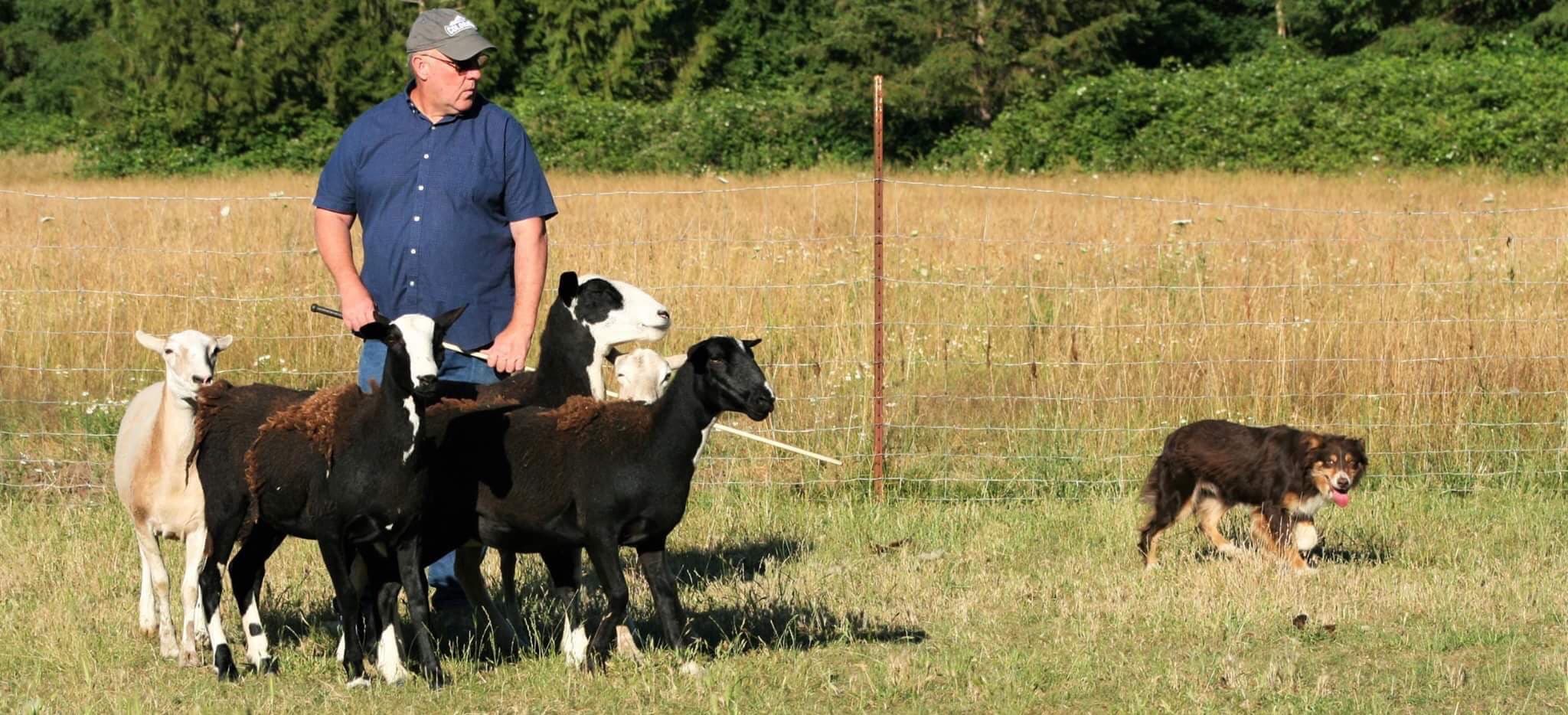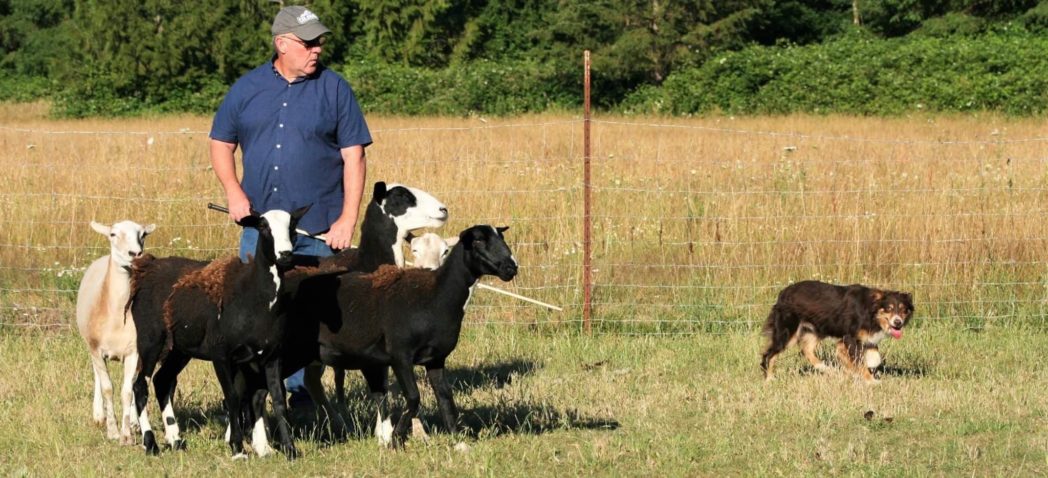by Andrea Scott
I conducted this interview in the spring of 2019. It is done in an oral history format. As is often the case of oral history, subjects weave in and of their memories, which jump around. An oral history often reflects speech patterns that give researchers more insight into the subject who is interviewed and that so no editing was done for this interview.

When you mention the name Mike Ryan, you may get a puzzled look. “Mike Ryan?” Others who have been a part of the founding of ASCA’s Stock Dog Program will shake their head yes, and say: “Yes, of course”.
Ryan is a breeder judge, trains his own working dogs that he also uses on his Oregon farm.
When he’s not engulfed in the world of dogs, he teaches the 5th grade, but has taught K-8 and at the University. Ryan also speaks some Spanish to better communicate with people.
Interview
I grew up on a farm in Minnesota in the fifties, sixties, and seventies. My father bought and sold livestock in the South St. Paul, Minnesota stockyards, which was the largest stockyard in the world at the time. He also bought and sold livestock privately and in various local sale barns. He started as a horse dealer and eventually dealt mostly in cattle. While I was still at home he shipped a lot of dairy cattle to Mexico and was well known locally. My father did not like dogs, but his father and my grandma’s brother used to debate about the best working dogs and they told me endless stories of the merits of good working dogs. There were stories of bob tailed dogs and blue dogs and any number of other local descriptors that approximated what we call Aussies today.
Being brought up in the livestock business exposed me to a wide variety of livestock handling methods. In those days there wasn’t nearly as much inventive equipment as I see now, but that resulted in some impressive dogs. I am proud to say that I got to see some spectacular working dogs. There were all kinds of working dogs, but over time it was the same breed that kept catching my eye. They were the funny colored dogs that we know as Australian Shepherds. In the sixties and seventies, they were still known by a lot of different names, but they were clearly Aussies. My family’s first dog was actually a Border Collie, and that is what I was looking for when I realized that there were some Aussies available in the area. The Aussies that one heard of back then were typically Ely, Woods, Harpers Old Smokey, and of course Hartnagle dogs. Hartnagle dogs are now known as Las Rocosa dogs.
The first Aussie that I worked myself was half Woods, one-fourth Ely, and one-fourth Hartnagle. He was a heck of a dog, but I never actually owned him. He was a red and white dog named Christianson’s Calico Brownie McGee. I was about fifteen or sixteen years old and I didn’t know a thing about training working dogs other than the stories of my Irish grandfather and my Irish great uncle. With many of those early Aussies you didn’t have to know much because they wanted so much to please their people. I think that is why the Aussie originally went from obscurity to becoming so popular. My own first Aussie would have been considered Woods bred. Her dam’s side was probably from Ely blood as that is what one heard of in Minnesota and South Dakota back then. Her sire was a litter brother to Jones Reddy Teddy. The best dogs that I saw in the early seventies were usually a cross of Hartnagle and Woods lines. They were usually good looking dogs. Of course I am inclined to say Woods, but Fletcher Woods’ dogs were often close relatives to Juanita Ely’s dogs and Jay Sisler’s dogs. All of those people knew each other and that breeding traveled across the country because of some of those people. Some of what I am inclined to call Las Rocosa and Woods crosses may just as well have been Las Rocosa and Ely crosses. These early breeders catered to the working stock people.
There were a lot of them, and they crossed well with Las Rocosa dogs and with the other lines that used Taylor’s Whiskey and Taylor’s Buena. Those lines are still represented in many of the well-recognized working lines today. For example, Las Rocosa, Slash V, Pincie Creek, Hangin’ Tree, and so forth. Often I feel that people press me about some of the Woods dogs that I knew because they want to hear something that I don’t have to say. I am not promoting the line, nor am I speaking against it. I am saying that although there were good working dogs in that line, they did not work out for me. That could be said of any number of bloodlines.
Aussies weren’t a recognized breed with the AKC and they darned well needed to be able to work or they weren’t valued. The working lines that I mentioned earlier are behind all of the dogs today including the show lines. Harper’s Old Smokey was a Kansas dog and I knew two of his sons. One lived in Missouri and the other lived in Farmington, Minnesota about a mile or two from where Tom and Deb Conroy live today. Old Smokey is not only behind lots of working dogs, but he is stacked up in the pedigrees of virtually every show Aussie out there. People just don’t know it. The other old lines are preserved more strongly in the working lines.
I loved the Aussies, “back in the day.” And, I hate the term, “back in the day.” If it is ever attributed to me, it is a blatant lie. The Aussies of the past were not perfect. Greatness does not require perfection. As a matter of fact, many greats were greatly flawed. You can definitely quote me on that. We still have great dogs today. A few years ago I bred to a dog that I saw greatness in. I didn’t know the specifics of his pedigree, but I saw quality. I did not know what titles he had, but he could do a day’s work. Sometimes the politics of breeding to such a dog is deadly. All that I can reply to that is a shrug. When I first knew Aussies, and they were primarily a real working dog, I don’t ever remember anyone talking about ears or trim or much of anything like that. Whether a dog would hit heads or heels and whether it could gather stock was critical. That is when low heeling meant something. Body biters and tail swingers left marks on cattle and I can assure you that buyers like my father took that into account when they were negotiating prices. People at that time often referred to gathering as what many people call outrunning today and lots of Aussies would outrun. It just wasn’t called outrunning.
The best working dogs to me are dogs that are easily trained, courageous, and versatile. I really appreciate Aussies that work hard to understand what is expected of them and have the initiative to try. Steady minds and a positive attitudes are valuable. No real stockman or woman needs a low instinct dog. The less training it takes to make a dog, the better I like it. Early Aussies picked up a task a lot faster than most Aussies that I see today. Weak dogs will often take direction in trial situations, but are virtually useless in tough situations. There is no substitute for a dog that tries.
People get overly concerned about “correct” Aussie working style. Most of them simply attribute the term correct Aussie style to the style that they like. Aussies have had a huge range of style as long as I have known the breed. A lot of what gets promoted as correct is what is popular with the person doing the talking. I like dogs with a huge range of styles. I think that range of working styles is an asset to our breed. More eye or less eye does not make an Aussie better or worse. A better natural outrun or less outrun isn’t a make it or break it issue either. The Aussie didn’t come into being as a product of herding trial aficionados. Aussies should be practical working dogs. That is still the kind of Aussie that I like best.
My earliest Aussie would have been considered to be a Woods line dog and a lot of people ask why I didn’t go forward with that type of breeding as I acknowledge that many Woods line dogs were good workers. The truth of it is that I came up against several overwhelming problems. Epilepsy, bad bites, and very bad temperaments forced me to go in a different direction. There is still a bit of Woods breeding in my dogs today, but it does not go back to the dogs that had those problems.
As a matter of fact, the bitch that did carry me forward had a fair amount of Woods breeding on her dam’s side. She was sired by Slash V Little Rock, and I bred her to Las Rocosa Shiloh. There was something magical about the Las Rocosa and Woods cross, and these dogs had that magic. Everything I have today goes back to that cross. This shows in other bloodlines throughout the working Aussies today. Las Rocosa, Slash V, Fairoaks, Crown Point, Hangin’ Tree, and many more bloodlines go back to Joe Taylor’s dogs out of Moab, Utah. Even the Vest line can claim a connection to Taylor’s dogs. Taylor’s Whiskey and Taylor’s Buena are behind virtually every great working dog out there. That blood comes in varying degrees, but it figures prominently in the working Aussie. People don’t know how their working Aussies are connected because they don’t look that far.
It is inevitable when one talks bloodlines in the working Aussie that issue of adulterated bloodlines will become a topic. None of this has been proven, and in my opinion, happened as much or more in the show lines of the Aussie, but in the final analysis there is nothing to do about it now except breed the best working Australian Shepherds that we can. Closing our eyes to the merits of other people’s good working stock won’t do any of us any good. I think that finger pointing is a waste of time. I don’t think that there is any doubt that there has been a bit of “adulteration” of breeding in the working Aussies, but it is nothing new and really suited to an entire discussion of its own. There was a time when the Aussie was the preferred stock dog in North America. That didn’t change because of mixing of breeds on the working side of the breed. It came from breeders who did not focus and sustain working ability. That in itself is not immoral if one doesn’t want or need working dogs. It just doesn’t help the breed as a preferred stock working breed. We can still do something about it and I for one will breed to the best working dogs that I can find. They usually trace right back to the bloodlines that were the best when I first came into this breed.
The Hartnagles
If people know little to nothing about me, the one thing that they will often know is that I am friends with the Hartnagles. Any friendship that has spanned five decades and several generations of a family is certainly one to be proud of and I am proud to say that I value my friendship with every member of the Hartnagle family that I have been honored to know. On more than one occasion I have referred to Ernie Hartnagle as my best friend and I know that he has said the same of me. For me, that is priceless. As I review this very article, Ernie is in hospice care and we are counting the days and hours.
Over the years I believe that Ernie was often under appreciated. He was a knowledgeable farmer and rancher. Ernie’s breadth and wealth of knowledge contributed immensely to the working Aussie. He knew what real stockmen and women needed and he never lost sight of that. Ernie kept all kinds of Aussie people in mind throughout times when the breed could have splintered. In his own era, Ernie was competitive in trials and extremely knowledgeable. While trials have expanded greatly over the years, and the opportunity to work dogs has also expanded, working dog people often get measured by the quantity and fame of their Working Trial Champions. It may well be that in the earlier days of Aussies, some dogs with far less than a WTCH may have overcome more formidable challenges than we see with the carefully run trials today. Ernie knew, trained, owned, and bred many of that kind of Aussies.
While speaking of my connection to the Hartnagles and the working Australian Shepherd, many people don’t realize that Elaine Hartnagle contributed to the world of working Australian Shepherds. She had a ranching and farming background herself and Aussies were part of that. As a matter of fact, Juanita Ely was Elaine’s godmother.
Working Aussies kindled my friendship with all of the Hartnagles, but I would be remiss if I didn’t mention Jeanne Joy. To people who have come into the Aussies in the last twenty years or so, they don’t really know how much Jeanne Joy
did early on. While Jeanne isn’t as active as she once was, there are few people who have worked Aussies in as many real life situations as Jeanne Joy has over the years. As Jeanne Joy is a published author, I will let her speak for herself. However, her stories of working Aussies and real life working situations would fill more books than she has already penned. Jeanne’s siblings and I have all been friends for a very long time. My life with working Aussies, and my life in general would never have been the same without them.
It might interest the working Australian Shepherd world to know that there are many other long time Aussie people that I have been honored to call friends. Lois George was one of the kindest and most supportive Aussie people that I met when I came into the breed. I believe that I met her in 1974 or 1975. Her focus on temperament and health remain paramount in my thinking. Her foundation dogs are found in both show and working dogs throughout the Australian Shepherd breed.
Bob and Jean Carrillo were early working Aussie people that I came to know and was proud to call friends. Our conversations went well beyond our common interest in Australian Shepherds. I think that they often made an extra effort to keep me pointed in the right direction. Although I met Joan Carrillo a long time ago, I didn’t really get to know her until some time after I considered her parents to be my friends. Carrillos had good working Aussies, but I don’t think that they ever found the right dogs to cross into their old line and their breeding didn’t carry forward into our working Aussies like it might have. They started using Kelpies and that is what many people know them for now.
While I knew a lot of other early Aussie people, I didn’t always have the opportunity to get to know them better. There were so many people who contributed to our working Aussies. I would like to acknowledge them all, but I would risk forgetting someone who should not be forgotten. Walt Lamar is one of those people. Walt Lamar was an early Aussie expert. Everybody that I ever heard of, who knew Walt Lamar, liked him. He was an early conformation and stock dog judge. Walt had a major in agronomy. He owned Mansker’s Turk. Turk is behind Taylor’s Whiskey. Walt’s credentials in the Aussie world were not based on how many champions he finished or bred. He was a real rancher who knew working structure. When he judged conformation, that was the lens through which he viewed the dogs. When he judged a trial, he judged it more from the perspective of a practical stockman than from the perspective of a rulebook and a score sheet. Walt Lamar was not only an Aussie expert, but he was also known for breeding Hancock line Quarter Horses. Walt Lamar, like me, was one of Ernie Hartnagle’s best friends. I am not sure what else people would want to know about Walt. He contributed more to the working Aussie than a lot of better-known people. He was fair minded, encouraging, knowledgeable, and kind. There were a lot of lesser-known people who did a lot for our working Aussies and I am sorry to say that I have already forgotten some of them. Their names and faces come to mind in the course of conversations and memories.
Over the years I haven’t always had the time, money, or circumstance to trial my Aussies, but when I have, I have usually done well. When I reflect back on my years in working Australian Shepherds, I remember the early dogs as real working dogs more than trial dogs. They were the dogs with grit and shine. The old working Aussies had everything and every one of them worked. It was a given. More importantly, they weren’t just a working stock dog; they were dogs that were part of life for stockmen and women.





